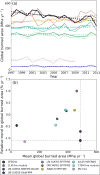A human-driven decline in global burned area
- PMID: 28663495
- PMCID: PMC6047075
- DOI: 10.1126/science.aal4108
A human-driven decline in global burned area
Abstract
Fire is an essential Earth system process that alters ecosystem and atmospheric composition. Here we assessed long-term fire trends using multiple satellite data sets. We found that global burned area declined by 24.3 ± 8.8% over the past 18 years. The estimated decrease in burned area remained robust after adjusting for precipitation variability and was largest in savannas. Agricultural expansion and intensification were primary drivers of declining fire activity. Fewer and smaller fires reduced aerosol concentrations, modified vegetation structure, and increased the magnitude of the terrestrial carbon sink. Fire models were unable to reproduce the pattern and magnitude of observed declines, suggesting that they may overestimate fire emissions in future projections. Using economic and demographic variables, we developed a conceptual model for predicting fire in human-dominated landscapes.
Copyright © 2017 The Authors, some rights reserved; exclusive licensee American Association for the Advancement of Science. No claim to original U.S. Government Works.
Figures





Comment in
-
Wildfire science is at a loss for comprehensive data.Nature. 2018 Aug;560(7716):7. doi: 10.1038/d41586-018-05840-4. Nature. 2018. PMID: 30065340 No abstract available.
References
-
- Bond WJ, Woodward FI, Midgley GF. The global distribution of ecosystems in a world without fire. New Phytol. 2005;165:525–537. - PubMed
-
- Crutzen PJ, Andreae M. Biomass burning in the tropics: Impact on atmospheric chemistry and biogeochemical cycles. Science. 1990;250:1669–1678. - PubMed
-
- Lelieveld J, Evans JS, Fnais M, Giannadaki D, Pozzer A. The contribution of outdoor air pollution sources to premature mortality on a global scale. Nature. 2015;525:367–371. - PubMed
-
- Bowman DMJS, et al. Fire in the Earth system. Science. 2009;324:481–484. - PubMed
-
- Scholes RJ, Archer SR. Tree-grass interactions in savannas. Annu. Rev. Ecol. Syst. 1997;28:517–544.
Publication types
MeSH terms
Grants and funding
LinkOut - more resources
Full Text Sources
Other Literature Sources
Miscellaneous

